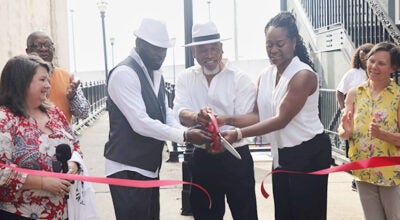Final phase of work begins on Cairo museum
Published 12:00 am Monday, June 25, 2001
Bracken Construction Co. workers Scott Whitley, left, and Derrel Granger bolt bar joints to steel beams that surround the USS Cairo. (The Vicksburg Post/MELANIE DUNCAN)
[06/25/01] The final phases of a project begun in 1993 will provide the Civil War gunboat Cairo more protection from the weather and from bombardment by birds.
Malouf Construction Co. of Jackson began work last week on a new canopy over the reconstructed remains of the historic boat the first warship to be sunk by an electrically detonated underwater mine or torpedo.
The USS Cairo is one of seven City Class ironclad gunboats built for Union forces during the Civil War by famous marine engineer James B. Eads. The boats were designed to help federal forces wrest control of the Mississippi River from Confederate hands.
The Cairo was built in Mound City, Ill., a few miles upstream on the Ohio River from its namesake city. The boat was delivered to the U.S. Navy on Jan. 15, 1862.
Later the same year, the Cairo was attached to the expeditionary force of Gen. U.S. Grant during the early stages of his Campaign for Vicksburg. On Dec. 12, the Cairo was sent up the Yazoo River, which joined the Mississippi several miles upstream of today’s Yazoo Diversion Canal, with several other vessels to clear mines and search out pockets of resistance from Confederate forces in the area.
Just before noon, the Cairo found her place in history when two explosions rocked the 175-foot vessel. Confederate torpedoes exploded on both bows of the Cairo.
As water began flooding in, the commander, Lt. Cmdr. Thomas O. Selfridge, ordered the Cairo run ashore. The crew was able to escape without loss or injury before the boat settled to the bottom of the Yazoo River not far downstream from where the U.S. 61 bridge at Redwood crosses. The stacks and other projections were knocked down later to conceal the location.
The deed was apparently accomplished well as it was not until 1956 that the resting place of the Cairo was discovered by a team that included Edwin Bearss, then historian for the Vicksburg National Military Park, and amateur historian Warren Grabau.
The boat was raised, in pieces, in 1963. As state and local leaders scrambled to raise money to restore it, the Cairo was taken to the Ingalls Shipyard in Pascagoula where it remained for years. Ownership was turned over to the National Park Service and the remains were reassembled as they are today. The display was formally opened more than 20 years ago.
The present canopy over the Cairo was begun in 1979. By 1992, deficiencies of the canopy were too obvious to be ignored, with gaping holes rusted in the roof and bird droppings accelerating the deterioration of both metal and wood.
Some of the first work on the new project to replace the canopy was the erection of a temporary canopy between the existing one and the Cairo, said Emily Joyner, curator of the Cairo Museum. It is to provide some protection once the old canopy is removed from dropped objects during construction. Workers also removed the smoke stacks and flag staff.
“We expect that first phase will last a couple of weeks,” she said.
The project schedule calls for the work to be completed in about 10 months.
The park service has $2,966,200 budgeted for the new canopy.
While the work is in progress, park officials said the adjacent Cairo Museum will have to be closed from time to time to provide for the safety of visitors.
Since access will be limited, visitors should contact the park staff working at the Visitor Center at the park entrance to see if the museum is closed. There is a small display of Cairo artifacts and a 6-minute video at the center.
The Vicksburg National Military Park, created by Congress in 1899, is visited by about 1 million people per year. State memorials, the National Military Cemetery and the Cairo are key attractions in the park.





